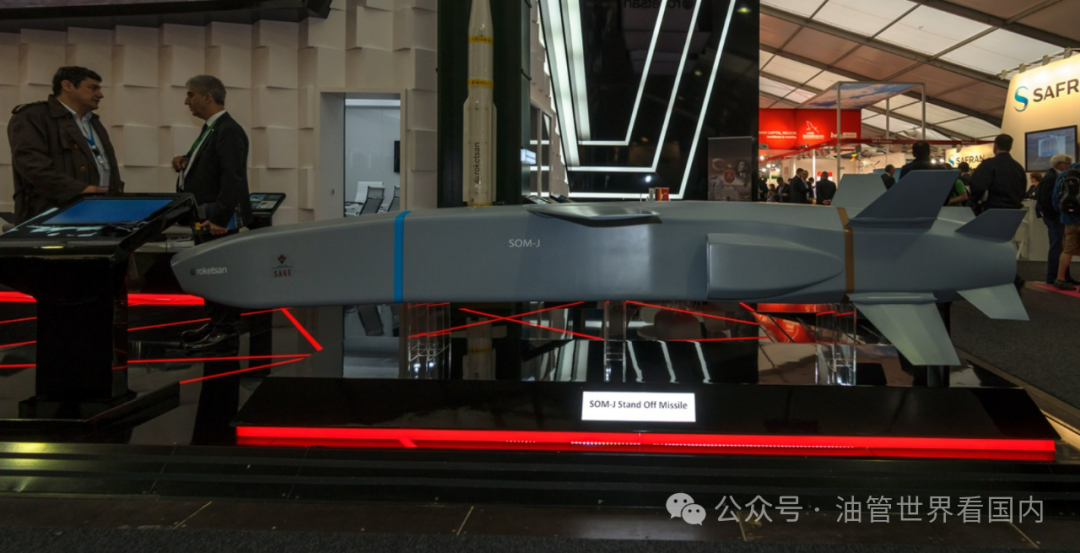This article is sourced from the American political journal “National Interest”

The modular design and extended range of the SOM-J missile make it attractive in the international market.
Despite domestic political turmoil, Turkey continues to strive for self-sufficiency in defense technology — part of a broader strategy to break free from the constraints of European neighbors and achieve hegemony in the Middle East. The latest system developed by Turkey is the SOM-J (Stand-off Munition – J) cruise missile.
The SOM-J cruise missile was co-developed by the Turkish Scientific and Technological Research Council’s Defense Industries Research and Development Institute and Roketsan, representing a significant leap in Turkey’s precision-guided munitions field.
The SOM-J is a variant of the SOM series, which was initiated in 2006 and is Turkey’s first domestically developed cruise missile. The Turkish Scientific and Technological Research Council’s Defense Industries Research and Development Institute is very similar to the U.S. Defense Advanced Research Projects Agency (DARPA), with outstanding innovative research and design; it was the first to undertake this project aimed at creating a weapon capable of striking stationary and moving targets from a safe distance (initially over 111 miles).
Turkey’s SOM cruise missiles
Turkey’s SOM series of cruise missiles includes iconic models such as SOM-A, SOM-B1, and SOM-B2, which have been in service with the Turkish Air Force since 2011 and are deployed on platforms like the F-16 Fighting Falcon and the F-4E2020 Terminator. However, the SOM-J emerged as a special iteration, initially tailored for integration with the internal weapons bay of the F-35 Lightning II — a result of the formal collaboration between the Turkish Scientific and Technological Research Council’s Defense Industries Research and Development Institute, Roketsan, and Lockheed Martin in 2014.
Unfortunately for Ankara, Turkey was expelled from the U.S. F-35 program in 2019 due to its purchase of the Russian S-400 air defense system (after the Obama administration refused to sell Patriot missile batteries to its NATO partner), which also altered the development timeline of the SOM-J.
However, Turkey did not abandon the project but instead shifted its focus to integrating the missile with domestic platforms such as the F-16, the upcoming KAAN fifth-generation fighter, and drones like the Bayraktar Akıncı and Bayraktar TB2.
Faced with the West’s stubborn stance, Turkey has demonstrated adaptability, highlighting the logic behind its shift towards a technology self-sufficiency strategy, which is a cornerstone of Turkey’s defense policy under initiatives like “National Defense R&D”.
Specifications of the new SOM-J cruise missile
The SOM-J is a truly next-generation autonomous precision cruise missile designed to destroy well-defended land and naval targets. With a range exceeding 270 miles, it is a highly effective stand-off weapon. Its low radar cross-section enhances the missile’s inherent stealth capabilities, allowing the SOM-J to evade most enemy air defense systems.
The missile also employs advanced guidance systems. These systems combine Inertial Navigation (INS), GPS, Terrain Reference Navigation (TRN), and Infrared Imaging (IIR) seekers to ensure precise targeting — even in contested environments where GPS signals may be disrupted.
One of the standout features of the missile is its advanced data link capability, allowing for post-launch control. This includes the ability to re-target, update targets, cancel missions, and maintain silent communication, providing operational flexibility in dynamic combat scenarios.
The missile is currently powered by the French TRI-40 turbojet engine, but Turkish engineers plan to transition it to the domestic Kale KTJ-3200. Its modular design allows for different warhead configurations to meet specific mission requirements — whether targeting soft targets, hardened bunkers, or naval platforms.
On March 21, 2025, the SOM-J successfully struck a surface target. The missile was launched from a Turkish Air Force 401 Test Squadron F-16 fighter jet, accurately hitting a maritime target, showcasing its expanded role. This test, announced by Turkey’s Minister of Industry and Technology, Mustafa Varank, emphasized that the SOM-J is an “effective force multiplier” in modern warfare. Its capability for long-range strikes against naval targets fills a critical gap in Turkey’s arsenal, especially in the context of tensions in the Eastern Mediterranean and the Black Sea.
Of course, challenges exist.
The transition to a domestic engine, while a step towards autonomy, requires rigorous testing to ensure reliability. Integration with multiple platforms (especially advanced drones and Turkey’s fifth-generation KAAN) will require significant engineering work and investment.
While the missile’s range and capabilities are impressive, they must be continuously upgraded to keep pace with the evolving air defense systems in the region, particularly those operated by Greece or Russia.
Fortunately for Turkey, the advantages of the system outweigh the drawbacks. The missile’s modular design and long range make it an attractive weapon on the international market, provided Turkey adheres to the missile technology control regime (MCTR) it has joined. Additionally, ongoing advancements in artificial intelligence and data link systems can enhance its autonomy and effectiveness, aligning with global trends in smart weapon development.
The SOM-J represents a true success for Turkey. It not only strengthens national security but also marks Turkey as a significant contributor to global defense technology.